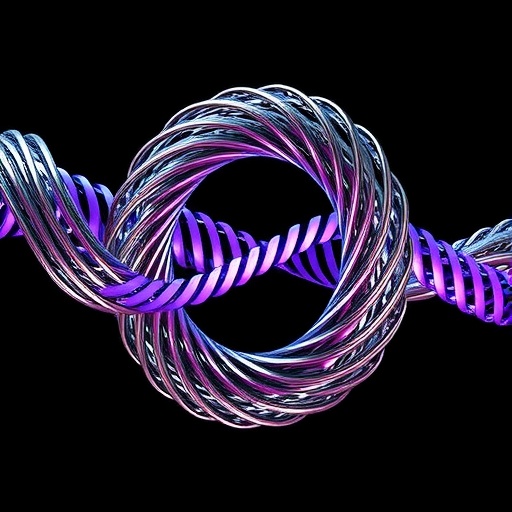In a groundbreaking advancement at the forefront of condensed matter physics, researchers have unveiled the first experimental realization of a metallic p-wave magnet, a novel quantum state of matter characterized by an odd-parity spin splitting. This class of magnetism arises not from strong electron correlations as traditionally expected, but from a distinct coupling mechanism between conduction electrons and a complex, spatially modulated magnetic texture—namely, a coplanar spin helix that intricately intertwines localized magnetic moments with delocalized charge carriers. The discovery signifies a paradigm shift in our understanding of magnetism, with profound implications for spintronics, magnonics, and the development of next-generation quantum materials.
Central to this phenomenon is the unique symmetry-breaking pattern of the magnetic structure. Unlike conventional antiferromagnets that typically exhibit zero net magnetization and preserve inversion symmetry, the p-wave magnet described here features a magnetic helix whose period is an even multiple of the underlying chemical unit cell. This configuration explicitly breaks space-inversion symmetry while approximately conserving time-reversal symmetry up to a half-unit-cell translation—conditions that symbiotically enable the emergence of p-wave spin splitting. Such unconventional symmetry properties allow the system to host electronic states with spin textures previously inaccessible in more common magnetic materials.
The theoretical foundation for p-wave magnetism dates back decades, initially proposed as a collective electronic instability in strongly interacting systems. However, recent theoretical advances have expanded the framework, suggesting that odd-parity spin-split bands can be realized without relying on electron-electron interactions of high strength. Instead, band structure effects mediated by magnetic order may suffice. The current experimental confirmation validates these emergent concepts and situates p-wave magnets as a unique platform to investigate the interplay between spin, orbital, and lattice degrees of freedom in metals.
Using cutting-edge X-ray scattering techniques, the research team captured detailed images of the antiferromagnetic spin helix, confirming its periodicity and symmetry characteristics with unprecedented precision. This experimental insight was critical to correlating the observed magnetic texture with the predicted electronic band structure modifications. Measurements revealed that despite the absence of a significant net magnetization, the material exhibits marked anisotropy in its electronic conductivity— a hallmark signature of p-wave spin splitting, thereby directly linking structural magnetism to tangible transport phenomena.
In addition to the odd-parity spin texture, the presence of small, yet finite, relativistic spin-orbit coupling imparts further nuance to the system’s electronic properties. This coupling marginally breaks time-reversal symmetry beyond the half-unit-cell translation, leading to an unexpected and unusually large anomalous Hall effect, a phenomenon rarely observed in antiferromagnets. The magnitude of this effect, characterized by a Hall conductivity exceeding 600 S/cm and Hall angles above 3%, positions the p-wave magnet as a standout candidate for practical application in spintronic devices requiring low-power and high-efficiency spin current control.
Theoretical modeling supports these experimental findings by demonstrating that the spin-nodal planes inherent to p-wave magnetism—a consequence of their unique symmetry landscape—are highly susceptible to even minor perturbations. Such perturbations readily open energy gaps in the electronic spectrum, enabling the generation of a pronounced anomalous Hall response. This underscores the delicate balance of symmetry-breaking mechanisms in dictating topological and transport properties, making p-wave magnets fertile ground for exploring fundamental physics and engineering advanced magnetic functionalities.
Crucially, this discovery situates metallic p-wave magnets as an ideal environment to probe the impact of spin-split electronic states across various phenomena including unconventional superconductivity and nontrivial spin textures. From a technical standpoint, the inherent coexistence of spin helicity and metallic conduction invites exploration into novel quasiparticles and collective excitations that may underlie next-generation quantum technologies. Moreover, the coupling of such states to external stimuli like electric or magnetic fields could unlock unprecedented avenues for manipulation and control in quantum materials.
The implications extend well beyond academic curiosity, touching the rapidly growing field of spintronics where control over electron spin—not just charge—heralds transformative advances. The demonstrated anisotropic conductivity and anomalous Hall effect offer robust functionalities that can be harnessed in spin-based logic and memory devices, potentially overcoming limitations imposed by traditional ferromagnetic materials. Notably, the near-zero net magnetization of p-wave magnets mitigates issues related to stray magnetic fields, enhancing device scalability and stability.
Looking ahead, the realization of p-wave magnetic metals mandates a reexamination of material design principles, incorporating engineering of magnetic textures alongside electronic band structure tailoring. The experimental approach leveraged here, combining resonant scattering with precision transport characterization, sets a new standard for uncovering subtle quantum orders in complex materials. This methodological blueprint may catalyze the discovery of analogous exotic phases with customized spin and charge functionalities.
Moreover, the p-wave magnet stands at an intriguing crossroads intersecting multiple research frontiers—quantum materials, magnetism, topological physics, and spin-orbitronics. As researchers further dissect the spin helix’s microscopic origin and its coupling to conduction electrons, the potential to synthesize bespoke materials exhibiting tailored p-wave behavior arises. Such materials could form the backbone of future devices exploiting nontrivial Berry phases, spin textures, and emergent collective excitations.
In conclusion, the experimental validation of p-wave magnetism marks a milestone, illuminating a path to harnessing complex spin orders without net magnetization, unlocking a suite of unexplored physical effects. The synergy between spatially modulated magnetic textures and electronic band structure breaks outdated paradigms and primes the field for rapid expansion. As this research evolves, it promises to fuel innovations in spintronics, quantum computation, and beyond.
Subject of Research:
Experimental realization and characterization of metallic p-wave magnetism arising from a coplanar antiferromagnetic spin helix.
Article Title:
A metallic p-wave magnet with commensurate spin helix.
Article References:
Yamada, R., Birch, M.T., Baral, P.R. et al. A metallic p-wave magnet with commensurate spin helix. Nature 646, 837–842 (2025). https://doi.org/10.1038/s41586-025-09633-4
DOI:
https://doi.org/10.1038/s41586-025-09633-4
Tags: condensed matter physics advancementselectronic states with spin texturesmagnonics innovationsmetallic p-wave magnetismnext-generation quantum materialsodd-parity spin splittingquantum states of matterspace-inversion symmetry breakingspin helix structuresspintronics applicationssymmetry-breaking in magnetismunconventional magnetic materials





